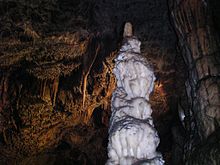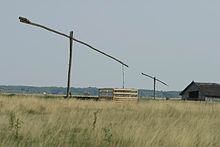National parks in Hungary
There are currently 10 national parks in Hungary. The areas fall under different IUCN protection categories but are listed as national parks by the Hungarian Ministry of the Environment.
List of national parks
The following national parks currently exist in Hungary ( Hungarian Nemzeti Park ):
| Surname | founding | Size [ha] | comment | map | view | |
|---|---|---|---|---|---|---|
| Hortobágy | 1972 | 80,549 | UNESCO World Heritage since 1999 ; Biosphere reserve since 1979 |
|

|
|
| Kiskunság | 1975 | 56,761 | Biosphere reserve since 1979 |
|
||
| Bükk | 1976 | 40,263 | The middle area of the low mountain range has had the status of a national park since 1977 |
|

|
|
| Aggtelek | 1985 | 19,892 | Biosphere reserve since 1979 |
|

|
|
| Fertő-Hanság | 1991 | 23,588 | Together with the Austrian National Park Neusiedler See-Seewinkel, UNESCO World Heritage since 2001 ; Lake Fertő has been a biosphere reserve since 1979 |
|
||
| Duna-Dráva | 1996 | 49,479 |
|
|||
| Körös-Maros | 1997 | 50.134 |
|
|||
| Balaton uplands | 1997 | 56,998 |
|
|||
| Duna-Ipoly | 1997 | 60,314 | Pilis biosphere reserve since 1979 |
|

|
|
| Őrség | 2002 | 43,933 | borders on the Austrian three-country nature park "Raab" and the Slovenian nature park "Goricko" |
|

|
|
| Szatmár-Bereg | not yet reported | |||||
| Total: | 481.978 |
National parks
Duna Dráva National Park
The Duna-Dráva National Park, founded in 1996 , is located between the Danube and the Drava , in southern Transdanubia. 45 ° 56 ′ 0 ″ N , 18 ° 45 ′ 0 ″ E
It covers an area of almost 500 km². The establishment of a national park in this landscape resulted from the need to protect the surrounding rivers in terms of water quality, but also from the fact that unique plant and animal species can be found here.
Hortobágy National Park
The National Park ( Hortobágyi Nemzeti Park ), located near Hajdúszoboszló , is the oldest and largest national park in Hungary. It covers an area of approx. 800 km² and is part of the largest grass steppe in Europe , the Puszta .
The national park is a biosphere reserve and much of it is a bird sanctuary, especially for water birds. This area became known primarily for its salt steppes. The area also offers a sufficient livelihood for great bustards . In addition, a large number of rare migratory birds find their resting place here. Hortobágy National Park became the 1999 World Heritage of UNESCO appointed.
Coordinates = 47 ° 36 ' N , 21 ° 6' E
Körös-Maros National Park
The Körös-Maros National Park was established in 1997 and is located in the south-east of the country.
The approximately 500 km² national park along the rivers Körösök and Maros is characterized above all by its lakes and rivers , which are of vital importance for migratory birds . Furthermore, this national park has an obligation to preserve the remaining areas of the still existing forests and the swamps occurring in this area as well as their population . There is also a reserve for bustards established in 1975 .
Duna Ipoly National Park
The National Park Duna-Ipoly or Danube-Ipoly with about 600 km² was founded in 1997.
Located on the so-called Danube Bend in the mountains of Pilis and Börzsöny , this national park is characteristic for its biodiversity of plants and animals, which can be traced back to the different natural habitats that dominate there. Many of the species found here are under nature protection . The diverse rock deposits are also worth mentioning . The Danube Island Szentendre is also part of the park.
Balaton uplands
The Balaton Oberland National Park was founded in 1997 . It covers an area of approx. 570 km².
The landscape is very diverse. The geyser cones to be found here are very interesting mainly from a geological point of view in relation to volcanism . The area of Klein-Balaton is characterized by a bird reserve in the area of Lake Balaton . This national park is also home to the Keszthely Mountains and moors , where rare plant species occur. In addition, the petrified remains of the Pannonian Sea can be found in the national park .
Kiskunság National Park
The Kiskunság National Park was founded in 1975 and lies between the Danube and Tisza rivers . It covers an area of almost 500 km².
A large part (110 km²) of this national park makes up the Bugac-Puszta biosphere reserve near Kecskemét, which was declared a biosphere reserve by Unesco in 1979. The two largest lakes in the national park, the Kolon lake near Izsák and the alkali lakes in Klein-Kumanien or upper Kiskunság , represent important water reserves.
Bükk National Park
The Bükk National Park is located between Eger , Miskolc and Szilvásvárad in northeast Hungary and has existed since 1977.
This national park is the largest in Hungary in a forest and park landscape and has an area of over 430 km²; almost 40 km² of this is specially protected. The Bükk Mountains, in which the national park is located, are the second highest in Hungary after the Mátra Mountains . At 960.7 m, its highest point is the southern summit of Kettős-bérc on the west side of the karst plateau.
Geologically speaking, the Bükk Mountains are relatively old. Its limestone originated between Carboniferous and Permian . During the Triassic and later, volcanoes gave rise to slate , basalt and tuff . The Bükk Mountains were raised about 15 million years ago.
The Bükk National Park is almost completely forested. On the western edge, where slate rock predominates, the oak dominates , on the plateau the beech (Hungarian: bükk ).
Some of the numerous caves can be visited. During the Stone Age, they offered people protection ( archeology , excavations). The many marked trails invite you to go hiking.
Fertő-Hanság National Park
The Neusiedler See-Seewinkel National Park , which was established jointly with Austria , has an area of almost 240 km².
It is a valuable habitat for its moor and swamp fauna.

Aggtelek National Park
The Aggtelek National Park was established in 1985. It is located in northeast Hungary and borders on Slovakia . The national park reaches an area of about 200 km².
In 1995 the cave system of the karst mountains belonging to the national park was added to the UNESCO World Heritage List. It includes several stalactite caves that have been made accessible to tourism . In addition, there are several places on the grounds of the national park that are historically valuable from the point of view of cultural history and are under monument protection.
Őrség National Park
The Őrség National Park is one of the younger Hungarian national parks. It opened in 2002.
It reaches an area of approx. 440 km² and results from the amalgamation of several landscape protection areas . The hills of the national park are criss-crossed by numerous streams and rivers; the climate is characterized by an above-average amount of precipitation . The area also has some reservoirs . In addition to the typical plant species for the area, there are also plants that can only be found here in Hungary, such as the mountain chamois. There is also a diverse selection of animal species, especially butterflies and dragonflies . The occurrence of rare bird species such as the honey buzzard or the corncrake should also be mentioned here .
Web links
Individual evidence
- ↑ [1] ( Page no longer available , search in web archives ) Info: The link was automatically marked as defective. Please check the link according to the instructions and then remove this notice. Bükk at WCPA
- ↑ [2] ( Page no longer available , search in web archives ) Info: The link was automatically marked as defective. Please check the link according to the instructions and then remove this notice. Bükk: Description in English with information on geology, flora and fauna
- ↑ [3] ( page no longer available , search in web archives ) Info: The link was automatically marked as defective. Please check the link according to the instructions and then remove this notice. Aggteleki at the World Commission of Protected Areas ( WCPA )

